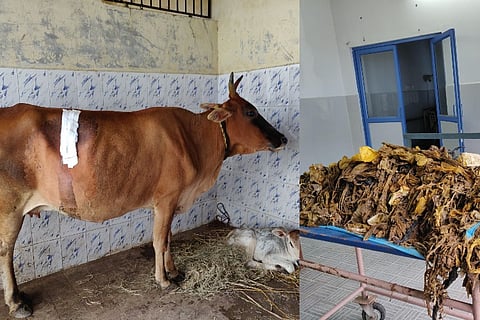

Often, we might have chanced upon this sight - bovine animals grazing garbage. In our haste, or perhaps due to the commonality of this sight, we rarely stop to do anything about it.
Therefore the case of 52-kilograms of plastic waste recovered from the stomach of a cow at Tamil Nadu Veterinary and Animal Sciences University (TANUVAS) in Vepery might not come across as a surprise to most of us. But the quantity is indeed shocking. TNM was allowed to see the retrived plastic trash that will now be preserved in formaldehyde for further study. We were shocked to find black plastic bags in full, aluminium foil, Maggi and ParleG wrappers amongst many other indistinguishable items piled up in the human-sized mound placed on a gurney.
A close up of the plastics
The accumulation of this plastic must have taken place over a period of two years opines Dr S Balasubramanian, Director (Clinics) at TANUVAS.
‘Suffered from severe stomach issues’
The cow, that has given birth to its third calf less than a month ago, was brought to TANUVAS by its owner P Munirathnam, an employee of the Ambattur Housing Society. Munirathanam, residing at Thirumullaivoyal, had purchased the cow just six months ago at a santhe (market) in Vellore along with three other cows. “I haven’t been receiving salary from my employer for the past 40 months and so to manage my family, I had to seek other ways,” says Munirathnam, whose first son is now studying medicine in Russia.
Munirathnam also tells us that the cow was pregnant at the time of purchase and looked huge and healthy.
Munirathnam with the cow and the calf
When the cow could barely feed its own calf with milk, Munirathnam was worried. “It was constipated, had trouble urinating and kept kicking its underbelly with one of its legs. There was absolutely no milk either. I knew something was wrong,” he says. As advised by the local veterinarian, Munirathnam took his cow to the Vepery hospital.
“The cow had just given birth but we knew something was wrong with its stomach. We proceed to take blood tests and x-ray scans and these tests revealed that a surgery was required,” says Dr Sivakumar who performed the surgery with help from Dr Velavan, Dr Sivasankar, Dr Selvaraj, Dr Nagarajan, Dr Arunama, under-grad and post-grad students.
Surgery that lasted for over 5 hours
The surgery was performed on Friday. “We administered area-specific anaesthesia instead of general anaesthesia. The cow would not have felt anything in the region around its stomach. The surgery was started at 11.00 am on Friday and concluded by 4.30 pm that day. During its entire course, the animal was on its feet. This is the only way to do it,” he tells us.
The cow, whom Munirathnam had not named yet, is now recovering at a small shed inside the Vepery college even as it drizzles outside. “In a week, it should regain its strength to stand on its feet. But it will take at least a month’s time for it to be able to produce milk,” adds Dr Balasubramanian.
As for its recovery, the animal is being fed bran mixed in warm water. Steps are also being taken to improve its gut health by transplanting cud from a healthy animal.
The cost of human carelessness
Dr Balasubramanian explains that indiscriminate feeding is in the nature of a ruminant (mammals that chew its cud). “A ruminant like a cow or a buffalo cannot differentiate food material from plastic. If food is wrapped in aluminium foil or plastic bag a dog or cat will claw it open, sniff to see if it can be eaten and will consume it only if it is to its liking. This is not the case for a ruminant. They have indiscriminate type of feeding,” he says.
Explaining further, he adds, “By its tongue rotation, it flips the whole material and then chews on it. The digestion process too is different. It chews on the cud which is brought back from its stomach’s chamber. That act is peculiar to ruminants. The plastic that is consumed along with food can never get digested and therefore it gets accumulated. The symptoms are not shown immediately but only after a long period. It may refuse feed, also defecation and urination may be a problem.”
While it may not be practically possible for anyone to monitor what a cattle feeds upon, people can still ensure that waste is disposed with more responsibility. “People should avoid disposing food materials wrapped inside plastic. We should also make sure needles and other sharp items too ate not disposed carelessly. If it ends up inside the stomach of an animal it will surely prove to be fatal.”